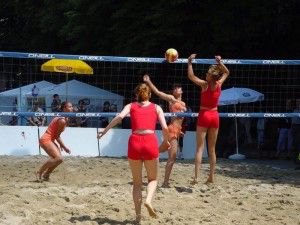What You Should Know About Patellar Tendinitis
- Posted On:
Patellar tendinitis is a common pain athletes experience from stressful activities that effect the knee area. Athletes who discover pain in their kneecap when working out should refrain from intense activity until the pain subsides to avoid overuse and further trauma to the tendon.
Below, Hoag Orthopedic Institute Chief of Staff Dr. Steven Gausewitz shares some information about patellar tendinitis, how to recognize the symptoms, and how to treat it.
What is patellar tendinitis?
Patellar tendinitis, also called  jumper’s knee, is a common cause of pain among athletes who play basketball, volleyball, and event cycling. Pain occurs in the area below the knee cap. This is the area where the patellar tendon connects the knee cap and the tibia. It gets stressed from activities like jumping, and can get inflamed and painful.
jumper’s knee, is a common cause of pain among athletes who play basketball, volleyball, and event cycling. Pain occurs in the area below the knee cap. This is the area where the patellar tendon connects the knee cap and the tibia. It gets stressed from activities like jumping, and can get inflamed and painful.
How does this differ from Patellofemoral Syndrome?
The patellar tendinitis just affects the tendon. The syndrome also includes pain in the area of the kneecap and the other tendons and structures in the front of the knee, including the joint between the kneecap and the femur.
What causes patellar tendinitis, specifically in cycling?
Athletes experience patellar tendinitis as a result of overuse. When there is too much stress on the tendon in your knee, the tendon may begin to tear, weakening the knee.
What are the symptoms of patellar tendinitis?
Pain around your kneecap is the first sign of a problem. Knee pain may begin only during physical activity, but it can quickly progress to the point of consistent pain and interfere with performance. When it worsens, the pain can interfere with day-to-day activities, and athletes should see a doctor as soon as possible.
How is patellar tendinitis diagnosed?
Doctors diagnose patellar tendinitis by applying pressure to the knee to find the source of the pain because patellar tendinitis pain is concentrated around the kneecap. Depending on the case, a doctor may recommend an x-ray, ultrasound or MRI to reveal more about the injury.
What steps should a cyclist take immediately after being diagnosed?
Refrain from intense workout. Shorten your ride.
Are cyclists advised to continue riding with patellar tendinitis?
Each case is different, depending on the severity of the pain and the progression of the condition – but generally speaking light exercise can help with the condition. Ensure that you include a good stretching regimen into your routine.
How is it treated?
Patellar tendinitis is typically treated using the tried and true R.I.C.E method, which includes rest, ice, compression and elevation. In some cases, physical therapists or physicians may recommend certain exercises to help build surrounding muscles.
How can cyclists prevent patellar tendinitis?
Cyclists can prevent patellar tendinitis by strengthening their thigh muscles so they can better handle stress that may cause pain. Athletes should stop activity immediately if they notice pain in their knees as a result of physical activity, and the more cyclists perfect their technique, the less likely they are to experience problems.
 Dr. Steven Gausewitz specializes in the treatment of degenerative and traumatic conditions affecting the hip, knee and shoulder. His focus is on adult reconstructive surgery, including primary and revision total joint replacement. His practice includes arthroscopic outpatient surgery. He has special interest in the development and utilization of less invasive surgical approaches and alternative bearing surfaces.
Dr. Steven Gausewitz specializes in the treatment of degenerative and traumatic conditions affecting the hip, knee and shoulder. His focus is on adult reconstructive surgery, including primary and revision total joint replacement. His practice includes arthroscopic outpatient surgery. He has special interest in the development and utilization of less invasive surgical approaches and alternative bearing surfaces.
You can find out more about Dr. Gausewitz here.